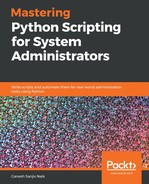A set is an unordered collection of elements with no duplicates. The basic use of a set is to check membership testing and eliminate duplicate entries. These set objects support mathematical operations, such as union, intersection, difference, and symmetric difference. We can create a set using curly braces or the set() function. If you want create an empty set, then use set(), not {}.
Here is a brief demonstration:
>>> fruits = {'Mango', 'Apple', 'Mango', 'Watermelon', 'Apple', 'Orange'}
>>> print (fruits)
{'Orange', 'Mango', 'Apple', 'Watermelon'}
>>> 'Orange' in fruits
True
>>> 'Onion' in fruits
False
>>>
>>> a = set('abracadabra')
>>> b = set('alacazam')
>>> a
{'d', 'c', 'r', 'b', 'a'}
>>> a - b
{'r', 'd', 'b'}
>>> a | b
{'d', 'c', 'r', 'b', 'm', 'a', 'z', 'l'}
>>> a & b
{'a', 'c'}
>>> a ^ b
{'r', 'd', 'b', 'm', 'z', 'l'}
Set comprehensions are also supported in Python. Refer to the following code:
>>> a = {x for x in 'abracadabra' if x not in 'abc'}
>>> a
{'r', 'd'}
